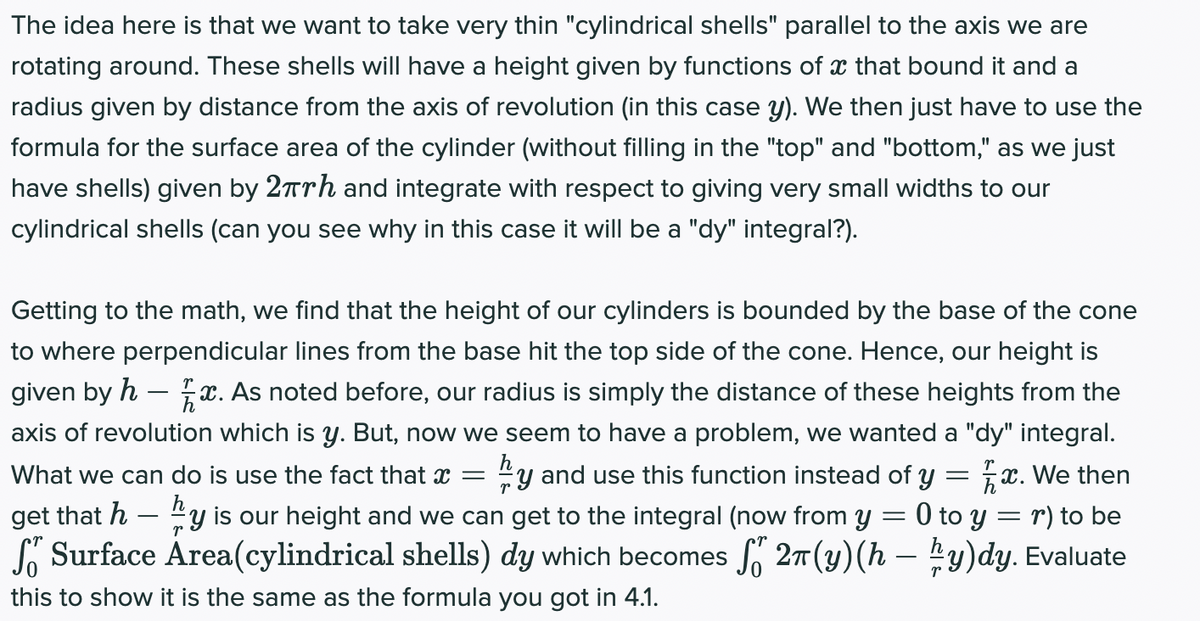The idea here is that we want to take very thin "cylindrical shells" parallel to the axis we are rotating around. These shells will have a height given by functions of x that bound it and a radius given by distance from the axis of revolution (in this case y). We then just have to use the formula for the surface area of the cylinder (without filling in the "top" and "bottom," as we just have shells) given by 2Trh and integrate with respect to giving very small widths to our cylindrical shells (can you see why in this case it will be a "dy" integral?). Getting to the math, we find that the height of our cylinders is bounded by the base of the cone to where perpendicular lines from the base hit the top side of the cone. Hence, our height is given by h – x. As noted before, our radius is simply the distance of these heights from the axis of revolution which is y. But, now we seem to have a problem, we wanted a "dy" integral. x. We then get that h – "y is our height and we can get to the integral (now from y = 0 to y = r) to be What we can do use the fact that x = use this function instead of y -
The idea here is that we want to take very thin "cylindrical shells" parallel to the axis we are rotating around. These shells will have a height given by functions of x that bound it and a radius given by distance from the axis of revolution (in this case y). We then just have to use the formula for the surface area of the cylinder (without filling in the "top" and "bottom," as we just have shells) given by 2Trh and integrate with respect to giving very small widths to our cylindrical shells (can you see why in this case it will be a "dy" integral?). Getting to the math, we find that the height of our cylinders is bounded by the base of the cone to where perpendicular lines from the base hit the top side of the cone. Hence, our height is given by h – x. As noted before, our radius is simply the distance of these heights from the axis of revolution which is y. But, now we seem to have a problem, we wanted a "dy" integral. x. We then get that h – "y is our height and we can get to the integral (now from y = 0 to y = r) to be What we can do use the fact that x = use this function instead of y -
Functions and Change: A Modeling Approach to College Algebra (MindTap Course List)
6th Edition
ISBN:9781337111348
Author:Bruce Crauder, Benny Evans, Alan Noell
Publisher:Bruce Crauder, Benny Evans, Alan Noell
ChapterA: Appendix
SectionA.2: Geometric Constructions
Problem 10P: A soda can has a volume of 25 cubic inches. Let x denote its radius and h its height, both in...
Related questions
Question

Transcribed Image Text:The idea here is that we want to take very thin "cylindrical shells" parallel to the axis we are
rotating around. These shells will have a height given by functions of x that bound it and a
radius given by distance from the axis of revolution (in this case y). We then just have to use the
formula for the surface area of the cylinder (without filling in the "top" and "bottom," as we just
have shells) given by 27Trh and integrate with respect to giving very small widths to our
cylindrical shells (can you see why in this case it will be a "dy" integral?).
Getting to the math, we find that the height of our cylinders is bounded by the base of the cone
to where perpendicular lines from the base hit the top side of the cone. Hence, our height is
given by h – x. As noted before, our radius is simply the distance of these heights from the
axis of revolution which is y. But, now we seem to have a problem, we wanted a "dy" integral.
5x. We then
0 to y = r) to be
So Surface Area(cylindrical shells) dy which becomes f 27(y)(h – y)dy. Evaluate
What we can do is use the fact that x =
"y and use this function instead of y
get that h – y is our height and we can get to the integral (now from y
-
this to show it is the same as the formula you got in 4.1.
Expert Solution
This question has been solved!
Explore an expertly crafted, step-by-step solution for a thorough understanding of key concepts.
This is a popular solution!
Trending now
This is a popular solution!
Step by step
Solved in 2 steps

Recommended textbooks for you

Functions and Change: A Modeling Approach to Coll…
Algebra
ISBN:
9781337111348
Author:
Bruce Crauder, Benny Evans, Alan Noell
Publisher:
Cengage Learning

Elementary Geometry For College Students, 7e
Geometry
ISBN:
9781337614085
Author:
Alexander, Daniel C.; Koeberlein, Geralyn M.
Publisher:
Cengage,

Functions and Change: A Modeling Approach to Coll…
Algebra
ISBN:
9781337111348
Author:
Bruce Crauder, Benny Evans, Alan Noell
Publisher:
Cengage Learning

Elementary Geometry For College Students, 7e
Geometry
ISBN:
9781337614085
Author:
Alexander, Daniel C.; Koeberlein, Geralyn M.
Publisher:
Cengage,